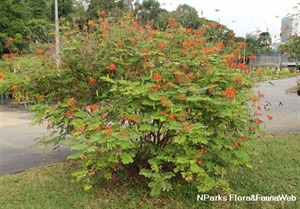Plant 18 Caesalpinia pulcherrima
Peacock Flower
Caesalpinia pulcherrima
| Plant Growth Form | Tree (Shrubby (1m to 5m); Small (6m-15m)), Shrub (Woody) |
| Native distribution: | Tropical Americas |
| Preferred Climate Zone : | Tropical |
Description :

Growth Form: Upright shrub, sometimes small tree, able to grow up to 3 - 6 m tall and with a spread of 2 - 4 m wide.
Foliage: Bi-pinnate foliage with small, oval leaflets.
Stems: Green, turning grayish-brown as the stems become woodier, covered with spines, which swell at the base upon maturity.
Flowers: Orange, yellow and red combination, scentless with long stamens and pistil. There is one modified petal which is smaller than the other 4 petals, flowers borne in terminal clusters.
Fruits: Oblong, flat pod, thin, up to 10 cm long. Pods split to disperse the single row of flattened seeds.
Cultivation :
This attractive shrub flowers throughout the year. Once a year hard pruning is recommended to retain the vigour of the plant. Blooming is reduced when plant is under too much shade. It can be easily propagated by seeds.
Ethnobotanical Uses :
Edible Plant Parts (Edible Fruits) Medicinal (The Indonesians pound the roots and give it to children afflicted with convulsions. The bark is used to treat diarrhoea. The flowers are claimed to be effective against intestinal worms and cure sores. The leaves are believed to have purgative properties and used to induce abortion and for fever. The west Indians pound the flowers and leaves into a decoction to treat fever. The seeds are used to cure breathing difficulty and chest pain.)

